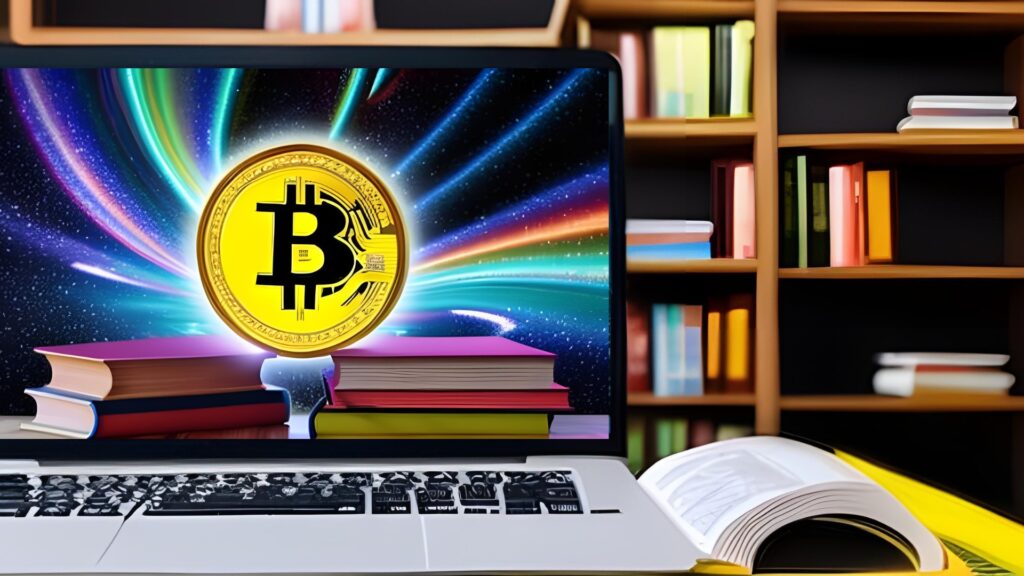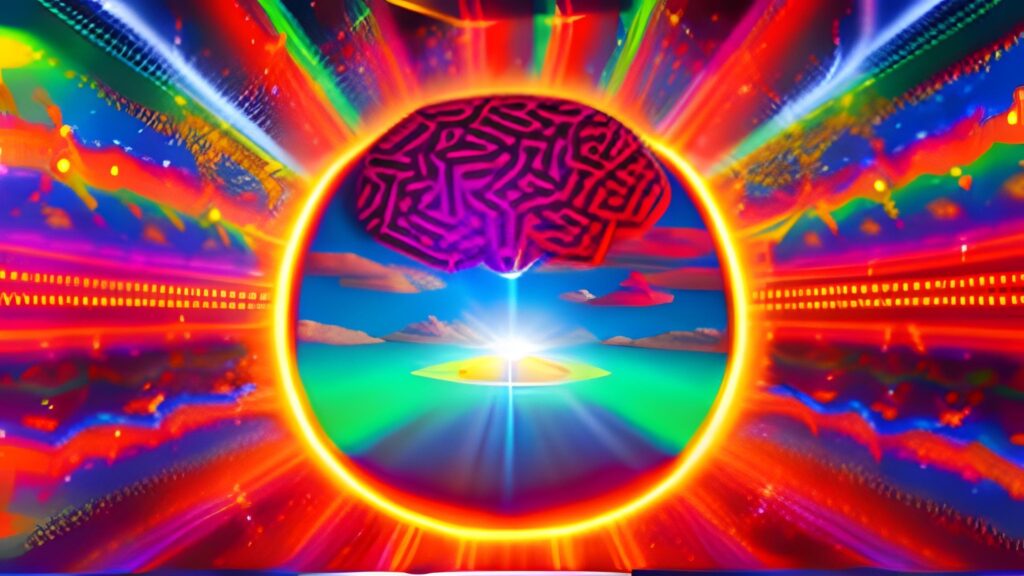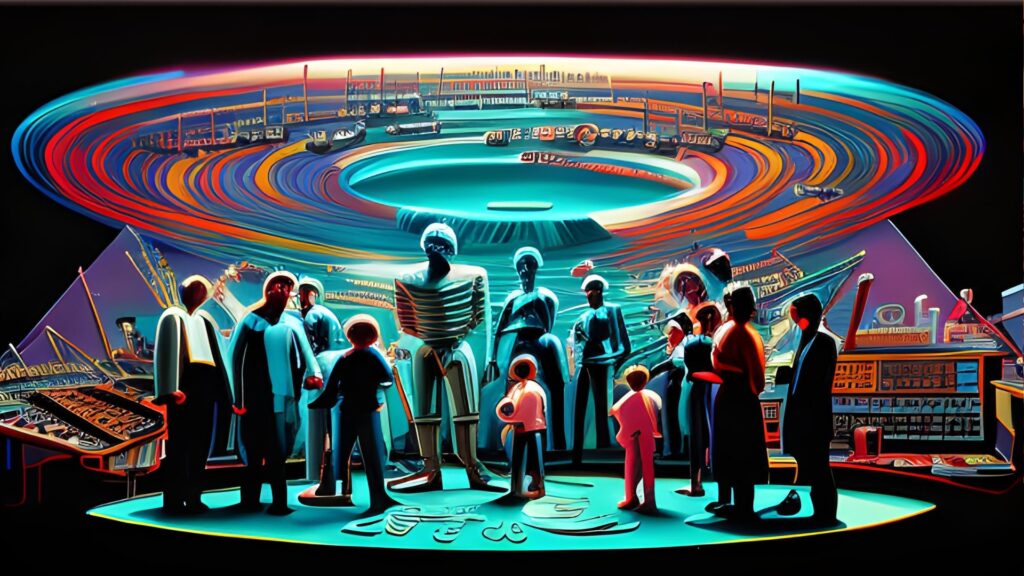
Quantum physics attempts to look at the vastness of this Metaverse, by breaking it down to the smallest units possible, or quanta, which is the unit of that measurement today. Laszlo defines quanta as packets of energy that have no specific form, though can take on a state of wave or particle in a multitude of variations. Entanglement describes a property of quanta, that can be seen in the social relationships that exist even beyond separation, through a responsiveness between quanta. Even over space and time, a correlation remains in experimental situations, that once having shared a state with another and being separated, the variable of quanta may not take a state until observed but when it is, all other quanta that were previously connected will choose or jump into a state so to speak, in opposing accordance with the observed state of the twin quanta. The non-locality of the response, that time and distance are irrelevant, as in no matter how far apart, and faster than the speed of light, is another indicator of an intrinsic connection in contradiction to separateness. (Laszlo 31-32)
Going even further, beyond physical reality and into the world of Metaphysics, Laszlo discusses the phenomena of consciousness with these concepts of quantum entanglement and the Akashic Field. He pulls from examples of tribal and ancient peoples sharing information indirectly, the power of archetypal symbology, as well as the transference of thoughts and ideas in the laboratory, defining such communicative links to the factors beyond our individual senses as transpersonal. Although such qualities of human consciousness are acknowledged in historical cultures, it is often cast aside as paranormal in the modern world.
However, laboratory results have confirmed transpersonal phenomenon, such as known through studies of demonstrating shared pain, response, and telepathy, between not just twins, but also those with deeply shared bonds, such as couples, parents and children, and even close friends. Also, through the rigorous testing of methods such as the Ganzfeld technique to the “distant mental influence on living systems” (DMILS) method, most all people seem to posses some form of psychic abilities. Beyond simply information sharing between minds, telesomatic abilities have also been evidenced in laboratory settings. Forms of Voo-doo practice, evoking materialized results on a subject through a consciously imbued representation, to prayer and spiritual healings, have over time and distance, yielded proven results. (Laszlo 41-43)

In another point of reverence for the wisdom of native cultures, Laszlo points to methods used among primitive and native practices of drumming, dancing, chanting, and fasting, among other activities used specifically to direct consciousness to an outcome or induce transpersonal abilities. Interconnections further demonstrating the capacities of the quanta are seen through meditation, with Laszlo pointing to evidence by physician and brain researcher, Nitamo Montecucco. His work revealed identical wave patterns with electroencephalogram (EEG) readings of the right and left brain hemispheres during deep meditation, as well as observing the wave patterns of different subjects become synchronized during group practice. In one such experiment documented by Dr. Maria Sagi, a healer performing a diagnosis during a deep state of meditation displayed a drop in EEG readings, into the deep Delta state, which in itself was surprising as it is recognized as the wave state of sleep. Even more surprising, was the ascent of the subject into an identical wave-pattern of the healer, as the healer was in the state of administering the conscious healing, despite having been placed in separate rooms. (Laszlo 91-93)
The work of Ervin Laszlo in “Science of the Akashic Field”, provides a foundation based in quantum physics of the possible mechanisms behind the power of a Universal All that the practice of meditation attempts to become aware of. Through the connections emanating from the compressed state in which all that is known today existed as, prior to the Big Bang, from which this Universe is sourced from and remains entangled. Despite the expansion from which All may have sprung, an innate coherence between all that is, remains intermingled in all that existed within the Universal seed before the initial jolt and essentially continue an informational exchange. Thus, the organism is intertwined with the environment, as is the environment intertwined with the organism.

Attunement to conscious fields between people is also discussed In Mind to Matter: The Astonishing Science of How Your Brain Creates Material Reality, by Dawson Church, in which over 10,000 brain-wave mappings of meditators were analyzed. Findings similarly included the sharing of brain rhythms of the healer and receiver during the time of the conscious healing connection. Beyond this, there was also a common shared state of mirrored brain activity between people during conversation, most especially during exchanges of visually and emotionally charged discussions, suggesting an unconscious communication of information and energy beyond that which we can perceive.
Church also reviewed studies of various healing techniques from Qui Gong, Healing Touch and Reiki, noting statistically significant results proving the effectiveness of such practices. Among the studies confirming the role of mind state, is of AIDS patients. Those with beliefs in a punishing God, had increased the levels of AIDS virus in their bloodstream, three times faster than those with the belief of a forgiving God. Essentially, cells use resonance to activate and heal. Resonance is a property of the Universe. Resonate coherence can be seen when multiple pendulum are set into motion, eventually synchronizing with each other into a common rhythmic pattern. Resonance can be seen with sand on a metal sheet that self-organize in accordance to musical vibrations. Planetary bodies and celestial objects resonate with one another in the solar system. The electromagnetic fields that encompass our planet, interact with the electromagnetic organ of the human brain and heart. Changes in the Earth’s magnetic field have an effect on all living beings. When resonance fluctuates through the Universe, there is organization from the micro to the macro. (Church Chapter 5).
Lipton’s examples of phenomena of the quanta revealing itself in the physical world and discussion of resonance, is supportive of the power of belief exercised by the consciousness to produce real-world responses and further show patterns of such elemental qualities throughout the natural world. In “Biology of Belief: Unleashing the Power of Consciousness, Matter, and Miracles”, by Bruce H. Lipton, Ph.D, the popular premises, from the historical authority of conviction by orthodox religion decreeing the separateness of man, to Newtonian’s mechanistic views to quantum physics. In this view, a graduation of thought from one of mechanical, clock-work operations of living function into one based upon the building blocks of energy is laid out. (Lipton 5-6)
He points out that French biologist Jean-Baptiste Lamarck’s earlier theories of evolution are becoming more reconsidered over Darwinian theories based on survival of the fittest individuals in light of the role of cooperation, opposed to competition in the natural world. Though he was ridiculed more than fifty years before Darwin, the element of cooperation over competition is also more aligned with the views that contemporary cell biologists have about the adaption of immune systems to the. (Lipton 10-12). On a cellular level, this can be seen in the cells’ ability to cooperatively link together to form more complex and successful organisms. Lipton explains the basic unit of life as proteins, which are the moving mechanisms within the cells that are controlled by signals in the external environment. It is from changes of the proteins’ electromagnetic charges that are responsible for their behavior-generating movement, controlling the internal functioning of living things, from digestion, metabolism, immune response and so on. Proteins are the complex molecules that act as effectors and receptors, communicating the external world to the internal. The once thought to be unchangeable blueprint of the double helix chromosome called DNA that dictated the organism, now underlies the outdated belief of genetic determinism. (Lipton 32-35)
Lipton discusses that emergence in the field of epigenetics, now understands that DNA may be the blueprint to make proteins, but it is the protein mechanism that correspond with relating signals between the cell and the environment, which actually controls the functioning of the organism by creating the behavior. “In the chromosome, the DNA forms the core, and the proteins cover the DNA like a sleeve.” (Lipton 43), demonstrating that proteins opposed to the DNA, is more critical to cellular functioning. It is observed that when a cell is stripped of the DNA, it is still capable of functioning. The cell eventually dies, as new proteins cannot be created without it, but without the proteins, cells immediately loose their ability to function. (Lipton 68-70) Lipton expounds that the relationship is certainly symbiotic as the DNA and protein membrane each make up 50% of the chromosome.
Thinking of the body as a cell, it is the receptors, the skin, eyes, ears, etcetera that picks up and sends signals to our nucleus, or brain. Essentially, rather than thinking of genes within DNA being on or off, it is rather a matter of a gene being covered by a protein membrane to activate it. So opposed to the thinking that it is genes that is the basis of control in an organism, we are now realizing that it is the proteins’ interaction with the environment that is at the heart of epigenetics, which is basically the study of gene modification. Therefore, a diversity of environmental signals, can lead to a diversity of genetic responses such as adaptive influences from parents prior to conception that can be inherited by offspring. (Lipton 43-46)
Through the language of biology and the field of epigenetics, Lipton offers a biological understanding of how we as organisms receive and interpret environmental signals that are beyond our sensory perceptions. The suggestion of survival of the fittest groups opposed to the individual, wherein the strong aid the weaker, thus strengthening the collective unit, also offers insight into the notion of meditation as a benefit to our human species and the collective environment as a whole.
Investigating other benefits of conscious awareness, The Science of Enlightenment by Shinzen Young, describes concentration power as lying at the base of the pyramid for all intellectual pursuits. Whether it is chemistry, mathematics, art, or sports, the ability to concentrate on any subject is the underlying component to incremental advancements in knowledge of every kind. Young also contends that although meditation offers the ability to improve life conditions though focused concentration, that reaching higher levels of consciousness also offers the capacity to find deep and innate happiness, despite external conditions. Attaining higher levels of growth during meditation in depth and breadth; depth in relation to how deep of a state one can attain and breadth as it pertains to how broad one can take the duration of practice over various levels of activity, such as to attain a deep level of concentration on breath, walking, biking, or any other daily activity, is the catalyzing component to growth and development. (Young Chapter 2). Beginning with consciousness, or the power and usefulness of being perceptive to our internal thought processes, we can see how simply an awareness of directing the mind can be life-changing, most especially if what our subconscious is programmed with is self-defeating or even self-destructive.









































